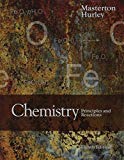
Bundle: Chemistry: Principles and Reactions, 8th, Loose-Leaf + OWLv2, 1 term (6 months) Printed Access Card
8th Edition
ISBN: 9781305717497
Author: William L. Masterton, Cecile N. Hurley
Publisher: Cengage Learning
expand_more
expand_more
format_list_bulleted
Concept explainers
Question
Chapter 22, Problem 33QAP
Interpretation Introduction
Interpretation:
The structures of the three compounds having formula C6 H4 ClBr should be drawn.
Concept introduction:
The molecule with same molecular formula but structural arrangement of atoms in the molecule is different are said to be isomers of each other.
Expert Solution & Answer
Trending nowThis is a popular solution!

Students have asked these similar questions
Consider a solution of 0.00304 moles of 4-nitrobenzoic acid (pKa = 3.442) dissolved in 25 mL water and titrated with 0.0991 M NaOH. Calculate the pH at the equivalence point
What is the name of the following compound?
SiMe3
K
Draw the starting structure that would lead to the major
product shown under the provided conditions.
Drawing
1. NaNH2
2. PhCH2Br
4 57°F
Sunny
Q Search
Chapter 22 Solutions
Bundle: Chemistry: Principles and Reactions, 8th, Loose-Leaf + OWLv2, 1 term (6 months) Printed Access Card
Ch. 22 - Classify each of the following hydrocarbons as...Ch. 22 - Classify each of the following hydrocarbons as...Ch. 22 - Write the formula for (a) an alkene with two...Ch. 22 - Write the formula for (a) an alkyne with 16...Ch. 22 - Name the following alkanes.Ch. 22 - Name the following alkanes.Ch. 22 - Prob. 7QAPCh. 22 - Prob. 8QAPCh. 22 - The following names are incorrect; draw a...Ch. 22 - Prob. 10QAP
Ch. 22 - Prob. 11QAPCh. 22 - Prob. 12QAPCh. 22 - Prob. 13QAPCh. 22 - Name the following compounds as derivatives of...Ch. 22 - Prob. 15QAPCh. 22 - Prob. 16QAPCh. 22 - Prob. 17QAPCh. 22 - Prob. 18QAPCh. 22 - Prob. 19QAPCh. 22 - Prob. 20QAPCh. 22 - Prob. 21QAPCh. 22 - Prob. 22QAPCh. 22 - Prob. 23QAPCh. 22 - Arrange these compounds in order of increasing...Ch. 22 - The Kbfor ethylamine (CH3CH2NH2) is 4.3104 . What...Ch. 22 - When aniline, C6H5NH2(Kb=7.41010) , reacts with a...Ch. 22 - When ethylamine, a weak base (Kb=4.3104) , reacts...Ch. 22 - When the conjugate acid of aniline, C6H5NH3+,...Ch. 22 - Draw the structural isomers of the alkane C6H14.Ch. 22 - Prob. 30QAPCh. 22 - Prob. 31QAPCh. 22 - Draw the structural isomers of C3H6Cl2 in which...Ch. 22 - Prob. 33QAPCh. 22 - Prob. 34QAPCh. 22 - Prob. 35QAPCh. 22 - Prob. 36QAPCh. 22 - Draw structures for all the alcohols with...Ch. 22 - Prob. 38QAPCh. 22 - Prob. 39QAPCh. 22 - Prob. 40QAPCh. 22 - Maleic acid and fumaric acid are the cis- and...Ch. 22 - Prob. 42QAPCh. 22 - Which of the following can show optical isomerism?...Ch. 22 - Prob. 44QAPCh. 22 - Prob. 45QAPCh. 22 - Prob. 46QAPCh. 22 - Prob. 47QAPCh. 22 - Prob. 48QAPCh. 22 - Prob. 49QAPCh. 22 - Prob. 50QAPCh. 22 - Prob. 51QAPCh. 22 - Prob. 52QAPCh. 22 - Calculate [H+] and the pH of a 0.10 M solution of...Ch. 22 - Prob. 54QAPCh. 22 - The general formula of an alkane is CnH2n+2 . What...Ch. 22 - Prob. 56QAPCh. 22 - Prob. 57QAPCh. 22 - Prob. 58QAPCh. 22 - Prob. 59QAPCh. 22 - Write an equation for the reaction of chloroacetic...
Knowledge Booster
Learn more about
Need a deep-dive on the concept behind this application? Look no further. Learn more about this topic, chemistry and related others by exploring similar questions and additional content below.Similar questions
- 7 Draw the starting alkyl bromide that would produce this alkyne under these conditions. F Drawing 1. NaNH2, A 2. H3O+ £ 4 Temps to rise Tomorrow Q Search H2arrow_forward7 Comment on the general features of the predicted (extremely simplified) ¹H- NMR spectrum of lycopene that is provided below. 00 6 57 PPM 3 2 1 0arrow_forwardIndicate the compound formula: dimethyl iodide (propyl) sulfonium.arrow_forward
arrow_back_ios
SEE MORE QUESTIONS
arrow_forward_ios
Recommended textbooks for you
 Chemistry: Principles and ReactionsChemistryISBN:9781305079373Author:William L. Masterton, Cecile N. HurleyPublisher:Cengage Learning
Chemistry: Principles and ReactionsChemistryISBN:9781305079373Author:William L. Masterton, Cecile N. HurleyPublisher:Cengage Learning Chemistry: The Molecular ScienceChemistryISBN:9781285199047Author:John W. Moore, Conrad L. StanitskiPublisher:Cengage Learning
Chemistry: The Molecular ScienceChemistryISBN:9781285199047Author:John W. Moore, Conrad L. StanitskiPublisher:Cengage Learning Introductory Chemistry: An Active Learning Approa...ChemistryISBN:9781305079250Author:Mark S. Cracolice, Ed PetersPublisher:Cengage Learning
Introductory Chemistry: An Active Learning Approa...ChemistryISBN:9781305079250Author:Mark S. Cracolice, Ed PetersPublisher:Cengage Learning Organic ChemistryChemistryISBN:9781305580350Author:William H. Brown, Brent L. Iverson, Eric Anslyn, Christopher S. FootePublisher:Cengage Learning
Organic ChemistryChemistryISBN:9781305580350Author:William H. Brown, Brent L. Iverson, Eric Anslyn, Christopher S. FootePublisher:Cengage Learning Chemistry by OpenStax (2015-05-04)ChemistryISBN:9781938168390Author:Klaus Theopold, Richard H Langley, Paul Flowers, William R. Robinson, Mark BlaserPublisher:OpenStax
Chemistry by OpenStax (2015-05-04)ChemistryISBN:9781938168390Author:Klaus Theopold, Richard H Langley, Paul Flowers, William R. Robinson, Mark BlaserPublisher:OpenStax Chemistry & Chemical ReactivityChemistryISBN:9781337399074Author:John C. Kotz, Paul M. Treichel, John Townsend, David TreichelPublisher:Cengage Learning
Chemistry & Chemical ReactivityChemistryISBN:9781337399074Author:John C. Kotz, Paul M. Treichel, John Townsend, David TreichelPublisher:Cengage Learning

Chemistry: Principles and Reactions
Chemistry
ISBN:9781305079373
Author:William L. Masterton, Cecile N. Hurley
Publisher:Cengage Learning

Chemistry: The Molecular Science
Chemistry
ISBN:9781285199047
Author:John W. Moore, Conrad L. Stanitski
Publisher:Cengage Learning

Introductory Chemistry: An Active Learning Approa...
Chemistry
ISBN:9781305079250
Author:Mark S. Cracolice, Ed Peters
Publisher:Cengage Learning

Organic Chemistry
Chemistry
ISBN:9781305580350
Author:William H. Brown, Brent L. Iverson, Eric Anslyn, Christopher S. Foote
Publisher:Cengage Learning

Chemistry by OpenStax (2015-05-04)
Chemistry
ISBN:9781938168390
Author:Klaus Theopold, Richard H Langley, Paul Flowers, William R. Robinson, Mark Blaser
Publisher:OpenStax

Chemistry & Chemical Reactivity
Chemistry
ISBN:9781337399074
Author:John C. Kotz, Paul M. Treichel, John Townsend, David Treichel
Publisher:Cengage Learning